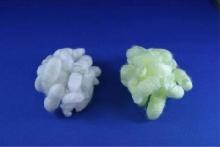Silkworms make silk thread. When a silkworm is preparing to change into a pupa, it spins silk thread into a cocoon to protect its body during the transformation. The cocoon consists of a single continuous silk strand that can reach up to 1,800m long, making them the longest single-strand thread found in nature. For a number of reasons, silk is considered to be a very high-quality type of thread: it consists entirely of protein, and is therefore gentle on the skin; it is also light and soft, and absorbs a good amount of moisture, making it comfortable to wear. The cross-section of silk thread is triangular, which gives it its unique sheen. This cross-section also causes it to make a rustling noise called a “scroop” when it rubs against itself. Nylon, the first synthetic fiber, was developed in an attempt to produce a man-made imitation of silk, but researchers were unable to mimic many of its desirable attributes. Today, some synthetic fibers have come closer, managing to replicate some of silk’s properties, but none so far has managed to surpass its luxurious feeling.
- Defense/Stability:
- Humidification
Researchers are currently investigating the possibility of introducing new genes into silkworms in order to produce silk with desired properties. Researchers have also made progress in developing techniques to process silk into powder, gel, or sponge form for use in cosmetics, medical materials, or adhesives for construction.
Through genetic engineering, it may be possible to have silkworms spin spider silk rather than their usual silk. Spider silk is extremely strong and durable. Similarly, because silkworms are able to produce such large amounts of silk, it may useful to engineer silkworms that can produce other substances in large quantities, such as medicine. Other possibilities include modifying silk worms to produce colored silk, or silk that glows when hit by certain kinds of light. Such advances would further improve the industrial usefulness of silkworms. Silkworms primarily eat mulberry leaves, so an increase in the industrial use of silkworms (sericulture) could also help support rural mountain villages in Japan and Korea that farm mulberry trees.


















